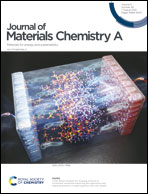High-capacity zinc–iodine flow batteries enabled by a polymer–polyiodide complex cathode†
Abstract
Consuming one-third of iodide to stabilize the iodine for reversible I−/I3− reactions is the major challenge for zinc–iodine flow batteries (ZIFBs) to realize high volumetric capacity. In this study, we report a polymer–polyiodide complex cathode to boost the iodide capacity of ZIFBs. By adding polyvinylpyrrolidone (PVP) to KI, electrochemical tests show that the formation of a polyiodide complex significantly promotes the oxidation of I− to I3− by enabling an enhanced solubility of the I2 film through interactions between PVP and I2. Materials characterization and theoretical calculation further prove that the lone-pair electrons of oxygen from the carbonyl group of monomer NVP facilitate the formation of an I–O bond and result in the breaking of the I–I bond in I2, creating an intermediate structure of NVP·2I−. Subsequently, the iodide in NVP·2I− can further complex with oxidized I2 forming soluble NVP–2I3−, which facilitates the dissolution of the I2 film and effectively frees up 1/3 iodide ions. Benefitting from the polyiodide complex, a ZIFB demonstrates a superior discharge capacity of 115 A h L−1 for up to 6 M I−, significantly unlocking the capacity of iodine. For long-term operation, the ZIFB with PVP in 6 M I− can continuously run for 600 cycles, affording a stable energy efficiency of 70%.



 Please wait while we load your content...
Please wait while we load your content...